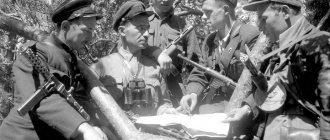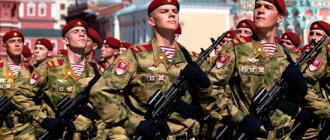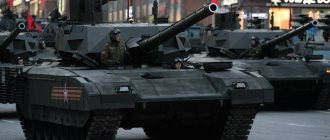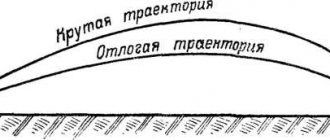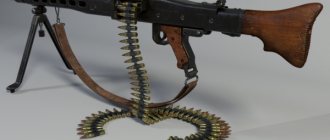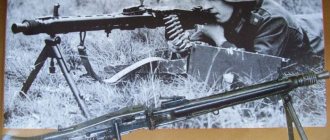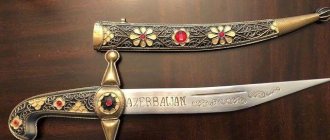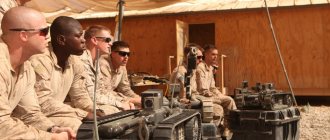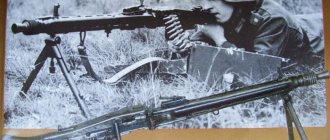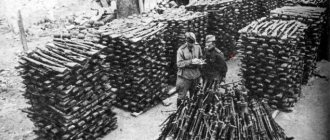Hitler carefully prepared for World War II and prepared a well-trained and equipped army for its outbreak. The entire German army consisted of two branches of the military: the Wehrmacht and the SS. The first are the real fighters, who bore the brunt of conquering territories. The second are punishers, spies and intelligence officers. These two types of troops were radically different from each other, had different tasks and composition.
The formation of the Wehrmacht and the SS took place under different conditions and at different times. These troops have one founder - Adolf Hitler. Initially, the Wehrmacht was created for external activities; it was supposed to serve as a reliable defense of the Third Reich from external enemies. The SS, on the contrary, was more aimed at internal activities and was supposed to ensure security within the country.
In 1925, Hitler was released from prison. The first thing he did was create a personal guard of eight people and called it SS, from the term "SchutzStaffel", which stands for cover squadron. Subsequently, the size of the SS began to expand. Hitler planned that the quantitative composition of the SS would be at the level of 10% of the total German army.
SS soldiers against the background of a destroyed US tank
SS soldiers against the background of a destroyed US tank
Germany's traditional armed forces began to emerge in 1935, based on the Reichswehr. The new army received the name Wehrmacht from the German words “wehr” - weapons, defense, and “macht” - strength, power.
Structure of military formations
The structure of the SS was heterogeneous. The formation constantly grew and captured new spheres of influence. There was no single direction of work in the SS. Members of the SS were simultaneously engaged in organizational work, management of death camps, and work in the security service. During World War II, the SS had 38 divisions.
Soldiers with SS stripes - zig runes in the form of two lightning bolts
Soldiers with SS stripes - zig runes in the form of two lightning bolts
The Wehrmacht army had an extremely simple structure, which was approximately the same in all Allied armies. The Wehrmacht consisted of ground forces, navy and air force. The total strength of the Wehrmacht before the start of the war was about 7 million people. During the war years, as a result of mobilization, it increased to 17 million people. At the head of the Wehrmacht was the Supreme Commander-in-Chief, i.e. Adolf Hitler himself.
Wehrmacht soldiers
Wehrmacht soldiers
Rank system and organization of the SS
The SS had a similar combined arms system of ranks, although some of them were introduced specifically for this unit and had no analogues. So, for example, Scharführer and Oberscharführer were equal in legal status to non-commissioned sergeant major and sergeant major, but in fact allowed them to occupy higher positions.
The assault unit consisted of 38 divisions. Each infantry division had an air defense unit and a supply battalion, a mortar unit was assigned to the tank division, and in terms of the number of personnel they were larger than the army. The non-combat SS units included traffic police, postal guards, escort battalions for Hitler and Himmler, military correspondents and military geologists.
Recruit Requirements
Until 1943, only volunteers asked to join the SS. The selection was very strict and not everyone could get a job. Service in the elite ranks of the SS was considered very prestigious, so there really was someone to choose from. Completely healthy young Germans between the ages of 25 and 35 could join the SS. In addition, 2 members of the National Socialist German Workers' Party had to vouch for the candidate.
Everyone else joined the Wehrmacht: those who did not join the SS or who simply did not think about serving in a particular branch of the military and were waiting for any call.
SS crimes and consequences
The main feature of the SS during the war was ruthlessness towards civilians and fanaticism in the execution of orders. The most significant and brutal crimes are:
Some crimes went unpunished because charges were either not brought at all, information was carefully hidden for political reasons, or they were brought forward too late. The Einsatz groups that carried out the genocide of the population and guarded the concentration camps were assigned to the SS troops, so during the trials the blame for the crimes usually fell on the entire unit.
There are not many SS veterans left alive. Basically, they lead a closed lifestyle and do not like to remember their service in assault groups, rarely giving interviews. From time to time, high-profile trials are held in cases of war criminals who have been living for a long time on false documents.
The situation is completely opposite in the Baltic states. In Lithuania, Latvia and Estonia, the entry of the republics into the USSR is considered occupation, and the entry of German troops is considered liberation, therefore, marches of SS veterans, celebrations, reburials of the remains of soldiers and monuments are opened there every year.
Ideological difference and conflicts
Wehrmacht soldiers were raised based on Christian values. This was the opinion of one of the main founders of the Wehrmacht, General Werner von Fritsch. SS soldiers were brought up in a different ideology. Hitler said: “We are the church!” SS members had to be aware of their superiority over other people. Belonging to a special race permeated the entire ideology of the education of the SS men.
Officers in Wehrmacht uniform
Officers in Wehrmacht uniform
It is noteworthy that conflicts regularly occurred between the Wehrmacht and the SS. The Wehrmacht command was always wary of the SS because it saw this organization as direct competitors. The SS command was formed from officers who had little military experience. Therefore, the SS men were often called “asphalt soldiers.”
But after the start of the war with the Soviet Union, such ridicule disappeared. The SS soldiers showed what they can do in battle. They fought desperately and had high morale. It was the SS men who most often carried out punitive operations to exterminate the local population, although it was precisely in these operations that courage was not needed. It is not difficult to fight against unarmed civilians.
Members of the SS at times received additional supplies in the form of food. This very often caused negativity on the part of Wehrmacht soldiers, who did not have additional bonuses.
Officers in SS uniform
Officers in SS uniform
There is a known case when, in the Demyansk cauldron, General Walter von Brockdorff-Ahlefeld demonstratively protected the army units of the Wehrmacht and fundamentally threw SS soldiers into the most dangerous directions. This was his way of demonstrating his dislike for the SS.
At the very beginning of the Normandy campaign, a serious conflict occurred between the commander of the 25th SS Regiment and the Lieutenant General of the Wehrmacht. Due to a dispute over who would be the first to attack the landing paratroopers, a serious firefight almost broke out.
Creation and structure of the Wehrmacht
In 1935, the main German armed forces were created, which bore the succinct name of the Wehrmacht. From German “wehr” is translated as “defense”, “weapon”, and the second part “macht” means “strength”, “army”, “power”. The Reichswehr became the foundation of the Wehrmacht. In this regard, the law “On the Construction of the Wehrmacht” was approved. It involved collecting taxes from every German citizen. This Law was completely contrary to the previously concluded Treaty of Versailles. According to it, the Wehrmacht should include 36 divisions, in which 500 thousand soldiers would serve.
In 1935, the main German armed forces were created, which bore the capacious name Wehrmacht // Photo: pikabu.ru
Three years later, the OKW was created - Oberkommando der Wehrmacht - the Wehrmacht command. It had enormous powers and was subordinate to only one person - Adolf Hitler himself. The Fuhrer at that time was the commander-in-chief of all the armed forces of the aggressor country. It was to him that all personnel of the military group were obliged to take an oath of allegiance.
OKW consisted of four departments at once:
·
Operations department;
·
Abwehr – department of military and counterintelligence;
·
economic department, responsible for ammunition and providing troops with food;
·
general purpose department.
An experienced military man, Field Marshal General Wilhelm Keitel, was appointed the first commander of the Wehrmacht.
Command of German troops // Photo: collections.ushmm.org
Casualties in World War II
Wehrmacht soldier throws a grenade
Wehrmacht soldier throws a grenade
At the beginning of World War II, the Wehrmacht had about 7 million soldiers. Soviet statistics say that by the end of June 1944, the Wehrmacht had lost more than 7.8 million people killed and captured. In total, about 700,000 soldiers were captured during this time, which means the irreparable losses in killed amounted to about 7 million 100 thousand soldiers and officers.
After Hitler’s “invincible” army began to suffer significant losses at the hands of Soviet soldiers, mass mobilization began, during which more than 10 million people were drafted into the ranks of the Wehrmacht. Those. In total, the Wehrmacht numbered more than 17 million people.
Exact data on SS losses in the war is unknown. In 1939, the SS consisted of approximately 240,000 soldiers. In 1945, the number of SS men increased to 830,000, mainly due to conscription and mobilization.
According to available data, the SS lost about 70% of its personnel in World War II.
It is noteworthy that the soldiers of the Red Army simply hated the SS for atrocities against civilians and therefore tried not to take prisoners of the SS. So after surrendering, most often the SS soldiers faced a terrible fate - execution.
Did you like the article? Press your finger up and subscribe to the channel. Then our publications will appear in your feed more often.
What tasks did this unit perform?
Unlike the Wehrmacht, which was engaged only in combat operations, the SS also faced other tasks:
Among other things, the SS was considered the vanguard of the Third Reich and a kind of elite, so the recruitment of volunteers had its own characteristics. If the Wehrmacht recruited mainly city dwellers, the assault troops preferred to see rural residents in their ranks, considering them racially superior and more capable of understanding ideology. Over time, foreigners began to be recruited into the SS, first - ethnically close Scandinavians, then - Western Europeans and Baltic states, and at the final stage of the Second World War - Muslims. There was also the Ukrainian SS division “Galicia”, which, according to the memoirs of former commander Fritz Freytag, was impossible to control. It is also known about the Russian SS formations - the “RONA” and “Druzhina” brigades.
The physical and psychological preparation of the SS was at the highest level. The main quality that was required to possess was loyalty to the party and the Fuhrer personally, as opposed to the politically unreliable Wehrmacht. This explains the fact of the huge losses that the SS suffered in the event of military clashes, since the assault divisions were thrown into the most dangerous sectors of the front. The fighters were required to perform any task, including fighting civilians as part of the Einaztz groups, suppressing uprisings and guarding concentration camps, so fanaticism and moral indifference were the decisive qualities of the volunteers.
The awards established in the assault detachments made it possible to understand what tasks were assigned to the unit. In addition to standard combined arms orders and medals, there were the following types of awards:
German SS tank divisions - are they deservedly considered the “elite” of the Third Reich?
Surely, you have heard more than once about elite German divisions. Everyone knows about “The Death’s Head”, “Adolf Hitler”, “Das Reich” and others. It is generally accepted that only soldiers devoted to the ideas of Nazism served in such divisions. That is why such divisions acted much more effectively. But is this really so? Let's try to figure it out in this article.
No. 4 Ideology of divisions
As a rule, historians claim that fighters in such “elite” divisions were carefully selected, choosing those who were endlessly devoted to the Reich and the ideas of Nazism. Of course, morale and fanaticism can play a significant role in the combat effectiveness of a unit, but how can they be measured?
If we talk about support, we can count the number of shells or cartridges transferred. But ideologicalness is very difficult to define. Such units began to be formed in 1943, when the Wehrmacht could no longer boast of any particular successes on the Eastern Front. Probably, according to Hitler's plan, service in such divisions was supposed to inspire the soldier. It's one thing when you fight in the 5th Infantry or 10th Armored Division, and another thing when you're part of "Grossdeutschland" or "Adolf Hitler."
Tanks of the Adolf Hitler division. Photos are freely available.
Tanks of the Adolf Hitler division. Photos are freely available.
“Finally, all chance of major success disappeared. The high morale of the SS divisions that had been preserved until now was lost. Under the cover of stubbornly fighting tankers, entire formations retreated, contrary to orders.”
These are the words of the outstanding German general Guderian after the defeat at Lake Balaton. Let me remind you that this was in the spring of 1945, when many soldiers sometimes abandoned their positions and ran away. Therefore, the morale in such divisions was really high.
No. 3 Acquisition
Another distinctive feature, which in my opinion had a greater influence on the combat effectiveness of such “elite” divisions, is the number of soldiers and equipment.
For example, in an ordinary Wehrmacht division in 1943, about 17 thousand soldiers served. The number of some “elite” divisions reached 25, and rarely fell below 20. And the average SS division, by the time the Battle of Kursk began, had 19 thousand soldiers on its staff. And this despite the fact that the division had been fighting heavy battles for several months, but had not received reinforcements.
Soldiers of the SS division "Totenkopf". Photos are freely available.
Soldiers of the SS division "Totenkopf". Photos are freely available.
As for the composition of the divisions, there were also striking differences. The staff expanded not only with infantry, but also with tanks, artillery and armored vehicles. In such units there were 6 motorized infantry battalions, versus 4 in a regular one. The number of artillery also differed, due to additional divisions of large-caliber guns.
#2 Attitude of command
In the memoirs of Wehrmacht generals there are also complaints that the Reich leadership “protected” the SS men, and the army units suffered huge losses.
Often, such divisions were thrown for powerful attacks or with the aim of breaking through the front of the Red Army. When there was a threat of complete destruction, the SS divisions were the first to withdraw.
№1 Heavy tanks
As practice shows, the T-6 Tiger heavy tanks, which began to appear in the Wehrmacht armored forces in 1943, ended up only in such “elite” divisions. In rare cases, a company of such tanks could end up in a regular unit.
???? “The German tank crews were taken aback; they were shot at point-blank range from ancient cannons!” - how 19th-century cannons fought near Moscow
SS division "Adolf Hitler" on the march. Photos are freely available.
SS division "Adolf Hitler" on the march. Photos are freely available.
As a rule, about 14 heavy Tigers were part of such a division. Sometimes a division received several companies to increase its firepower.
Since by the time of the Battle of Kursk the Red Army had not yet received a sufficient number of T-34-85, IS-2 and SU-100, heavy German Tiger tanks posed a serious threat to the Soviet troops.
As a result, we can say that the “elite” divisions of the Waffen SS showed such high results on the battlefields, largely due to their increased staffing.
It should come as no surprise that a unit with 50 percent more infantry, 25 percent more tanks and 33 percent more artillery is highly effective.
Thanks for reading the article! Like,✅ subscribe to my channel we have ???? Telegram and ???? website. Write your opinion!
Question to readers:
Do you think the SS divisions can be called elite?
???? Which European countries sent their “volunteers” to the war with the Soviet Union in the ranks of the Waffen SS
Foreigners serving in the Wehrmacht and SS troops (19 photos)
Author: zaCCCPanec
29 September 2022 14:14
Tags: Collaboration second world war pages of history
8256
19
Collaboration during the Second World War. As we understand this well today, people who became collaborators during the Second World War were: 1) whose spirit was weak and whose moral principles were very low; and 2) who had their own views on the social system in their country.
0
See all photos in the gallery
Soldiers of the 13th SS Mountain Division "Handschar" in characteristic red fezzes.
Both are, in general, understandable and explainable. Such people exist, have been and will be. The only truly important question is: why were they so often so cruel to their own? That is, Hitler managed not only to attract people with a low level of morality from almost all over the world, but also to completely deprive them of their humanity and push them to commit atrocities against people of their own nationality, and even their immediate fellow citizens. And the number of such “guards” of the Fuhrer was by no means small. The count went into many thousands. First, let's look at the European collaborators.
×
0
And this is their emblem.
0
For example, in January 1944, their number in the SS troops was 37.3 thousand people, and among them were Norwegians (3.8 thousand people), Danes (5 thousand people), and Flemings (5 thousand people), as well as the Dutch (18.4 thousand people), as well as the Walloons (1.8 thousand people), and, of course, the French (2.4 thousand people), of whom The Germans themselves classified them as “Germans” already during the war.
0
Let us recall that “German volunteers” from among the “Volksdeutsche” who lived in Norway, Denmark, Belgium, and Holland, as well as ethnic Germans who lived outside Germany, fully staffed as many as 12 “volunteer” SS divisions: 5th ("Viking"), 7th ("Prince Eugene"), 22nd ("Nordland"), 18th ("Horst Wessel"), 22nd ("Maria Theresa"), 23rd ( "Nederland"), 27th ("Langemarck"), 28th ("Wallonia"), 31st ("Bohemia and Moravia"), 32nd ("January 30"), 34th ("Landstorm") Nederland"), 37th ("Lutzow").
0
The Fuhrer's soldiers fought under such banners. Well, who can read Arabic?
The SS command also formed such foreign divisions as the 23rd “Kama” and the 13th mountain division “Handschar” (from Croats, as well as Bosnians and Muslim residents of Herzegovina), then the 21st division “Skanderberg” was created from Albanians. , from the Italians the 29th, from the Hungarians the 25th “Hunyadi”, and the 26th “Tembes”, from the French the 33rd division “Charlemagne” (that is, “Charlemagne”) consisted, from the Lithuanians, Latvians (15- I, 19th), Estonians (20th), citizens of the USSR and simply former Russian citizens (29th “ROA”, 30th), Belarusians, Ukrainians (14th “Galicia”).
0
To distinguish the "volunteer" SS divisions manned by Norwegians, Danes, Dutch, Flemings and Volksdeutsche, they were called "SS divisions". During the war there were at least 15 of them. The exact number of such “volunteer divisions” and “SS divisions” is quite difficult to establish due to the existence of many smaller units - battalions, regiments, brigades, legions, also created under the auspices of the SS. Some of them were brought to the size of divisions, some did not have time to reach the required number, and some the SS command wanted to form, but did not have time, and they remained only on paper.
0
It is interesting that representatives of foreign states that were not occupied by Germany also served in the SS. For example, 101 Swedes served Hitler, there were more Swiss - 584 people, there were also Finns, Romanians, Bulgarians, Spaniards, who had their own national legions. And these were real volunteers - either fanatics or real adventurers, who often crossed the borders of their countries illegally just to take part in the “struggle against Bolshevism.” True, the number of such people was very small, but nevertheless there were some.
0
After lunch prayer. And the obligatory request is that your national god help Adolf Hitler.
Spanish volunteers also fought in the SS troops. For example, it was the 250th Infantry Division, which was part of the German Army Group North, and was in Russia for quite a long time, but then returned to Spain in October - November 1943. But there were soldiers and officers who remained to fight in Russia. From these ideological volunteers, the “Spanish Legion” (or “Blue Legion”, as it was called unofficially) was formed, which fought on the side of Nazi Germany until March 1944, when, by decision of the Spanish government, it was also recalled to its homeland.
0
There were blacks in the German army! "Corps F", or "Helmut Felmy", after the name of its commander. Operated near Rostov in 1942. Of his six thousand soldiers, three thousand are Arabs and blacks of the Maghreb.
Moreover, General Franco gave the order to close the Spanish-French border to such volunteers who might again wish to go to Germany. And yet, there were approximately 150 people who crossed the border illegally. Naturally, in France the German authorities received them very well and sent them to a training camp in Stablatt, near Konigsberg. And from there they again ended up... in a unit of the SS troops. As a result of all these “border crossings”, by April 1945, under the command of the former captain of the “Blue Division” Miguel Esquerra, now an SS Standartenführer (Colonel of the SS troops), there were three companies from the Spaniards and also a number of soldiers from the French and Belgian formations of the “troops”. SS." And the devotion of these volunteers was fully rewarded by Hitler himself, since the Esquerra Compound was tasked with guarding the Reich Chancellery. And it was precisely this army that fought in the last battles of May 1945 for the government quarters of Berlin. Fate was merciful to the brave Spaniard. He was captured, but managed to escape and reach Spain. No one pursued him there, so he even managed to write and publish his memoirs.
0
Member of the German African Nazi Party Ashkari along with members of the Austrian Nazi Party. This is such touching fascist “internationalism” in action.
That is, there really were volunteers who fought in the SS because of their own “consciousness.” However, there were in no way enough of them and they had to forcefully recruit “volunteers” into the SS troops. As a result, they began to differ little from the “colonial troops,” and those, as everyone knows, were extremely unreliable weapons at all times.
0
A group of Cossacks from the German troops on the southern sector of the Eastern Front. Dressed in Soviet overcoats and hats.
For precisely this reason, many SS units were either disbanded or created again, they were shuffled like cards and transferred from one section of the front to another, sections of the front, which is why it is so difficult to determine their exact number. Some units did not participate in hostilities at all, but were used as punitive and police units to deal with local residents of the occupied territories and fight partisans. The Germans had no illusions. And they understood that as soon as they were “their traitors,” they would be betrayed a second time, as happened, for example, with the “Russian SS squad.”
0
By the way, there were two “squads”: “1st and 2nd Russian SS squads.” Walter Schellenberg, head of the SS intelligence service (VI directorate of the RSHA), wrote in his memoirs that the “Druzhina” was formed from those Soviet prisoners of war who, as part of Operation Zeppelin, were being prepared for delivery to the Soviet rear. There they were supposed to engage in espionage and sabotage, but since their dispatch was often delayed, they were united into a combat unit, which was called “Druzhina”. Its commander was a former Soviet officer, Lieutenant Colonel Rodionov (who had the nickname Gill). At first there was only one “squad”, then a second one appeared, and in March 1943, they were united into the “1st Russian National SS Regiment”. Then the “1st Russian National SS Brigade” was created from it, and Rodionov first became the commander of this regiment, and then the commander of the brigade. Schellenberg wrote that he warned his superiors not to use these Russian formations in punitive actions against the partisans. That in this case it is possible for the brigade to go over to the “Reds” side. And he, one might say, looked into the water!
0
In August 1943, the brigade was again involved in combing the village in search of partisans. Noticing a column of Soviet prisoners of war, who were guarded by SS soldiers, the brigade soldiers attacked the convoy, freed the prisoners and went with them to the partisans. It turned out that Rodionov had contacted the partisan detachment in advance. Zheleznyak, and through him the leadership of the partisan movement in Moscow. They believed him, and the whole operation went “without a hitch,” and he even made provision for the arrest of the most inveterate traitors among the brigade commanders, who could resist when going over to the partisans. It is clear what consequences this “betrayal” had, but... the policy towards collaborators has not changed. There are no people - you will use whoever you have to!
0
However, the most surprising and, in general, phenomenon that is very difficult to explain was the use by the Nazis of various Muslim, Caucasian and Turkic formations. And this after Himmler himself called them “savage peoples.” And moreover, their formation within the “SS troops” completely, 100% contradicted all Nazi racial doctrines, and the very purpose of the SS organization, which was originally conceived as a “union of specially selected Nordic Germans.” And here? Flat faces, narrow eyes... Well, such Nordic signs that there’s simply nowhere else to go!
0
It is not clear why, but Hitler was particularly distrustful of the volunteer units of collaborators recruited from the peoples of the USSR, and only saw Muslims as those on whom he could rely. For example, in December 1942, at one of the meetings, he told his generals: “I don’t know how these Georgians will behave. They do not belong to the Turkic peoples; I consider only Muslims reliable. I consider everyone else unreliable. At the moment, I consider the formation of these purely Caucasian battalions to be very risky, while I do not see any danger in the creation of purely Muslim formations. Despite all the statements of Rosenberg and the military, I also do not trust the Armenians.” That's how! And once again it shows how dangerous it is to trust the opinion of a “brilliant leader,” especially... one who does not have a decent education, because most often it will be incorrect. But - the Fuhrer said and “the machine started spinning”: the formation of military units from Soviet prisoners of war from the “Turkestan and Caucasian nationalities” began, which included Uzbeks, Kazakhs, Tatars, Azerbaijanis, etc. Already at the end of 1943, the “1st East -Muslim SS regiment." In November 1944, it was turned into the “Eastern Turkic SS Forces Unit”, which was placed under the command of the SS Standartenführer... Harun al-Rashid. For some time it was listed as part of the 13th (Muslim) SS Mountain Division "Handschar", but later became a separate formation.
0
Soldiers from the 51st Division of the British Army next to prisoners of war from national units. The legionnaire on the left has a clearly visible emblem with the inscription TURKISTAN (another version of it is also known, where a bow and arrow was depicted).
In May 1944, in the Minsk region, the regiment took part in hostilities against the Red Army and... then what was supposed to happen happened. A large group of Kazakhs went over to the partisans. After this, the regiment, or rather what was left of it, was transferred to Northern Slovakia. But even there, in December 1944, 400 Uzbek soldiers and officers again went over to the partisans. The rebels were commanded by SS Obersturm-Führer Alimov, who at one time commanded this regiment.
0
A sentry from the Free Arabia Legion.
The British and American soldiers who landed in Normandy in June 1944 constantly noted that many of the “Germans” who surrendered to them turned out to be citizens of the Soviet Union. According to their estimates, these were about 10% of all captured soldiers of the German army. And many fled to the French partisans if such an opportunity presented itself.
0
Very interesting photo. Chinese Jiang Weiguo in the Wehrmacht fanen-junker (officer candidate) uniform.
In one of the comments to the first part of this material, the question was asked: did the blacks fight for the Germans? Yes, we fought. Because the command of the German armed forces, and especially the leadership of the SS, did not consider it anything special to use “cannon fodder” with any skin color. And if Reichsführer SS Himmler agreed to the creation of “national” units from Russians and Muslims, then there was a place for the British, Americans, and even Hindus and Arabs. And why are they worse? Moreover, there was another category of scum, whom they also did not disdain. These are actually German criminals, who, one might say, were ordered by God himself to “atone for their guilt before the Reich” by fighting the partisans as part of the “valiant SS troops.” And such a unit, naturally, was formed already in February 1942. It was a special SS Dirlenwanger battalion, which in 1945 became the 36th SS Dirlenwanger Division. Moreover, not only German criminals served in it, but also traitors from among the Ukrainian nationalists. Apparently, this audience turned out to be the closest in spirit to them, otherwise it’s difficult to explain.
The admission of criminals into the ranks of the SS took place right in the concentration camps, and the selection of candidates itself was reduced to a simple formality. In the camps, such “SS men” performed the duties of capos, guards, block seniors, etc. In Auschwitz, these prisoners had been, for example, since 1940 and “worked” together with the SS “Totenkopf” guards. Whatever crime they committed, they had nothing to fear from the gas chamber, they ate separately from other prisoners, had special rations and even... their own apartments in the camp, often well furnished, and even sold the things of the exterminated prisoners. That is, the fascists used almost any “human material”, as long as it had suitable “morality” and spiritual values corresponding to its “ideals”.
0
And this is who he became - that is, the experience of the German service benefited him. Jiang Weiguo is a general in the armed forces and the Minister of National Defense of Communist China. 1965-1969
And lastly, all this was by no means a secret to anyone in the highest echelons of power in the Reich. An open secret, so to speak, and nothing more. Thus, far from the last person in the SS hierarchy, and second after Himmler, SS Obergruppenführer Reinhard Heydrich, in June 1942 directly called the SS a “garbage can.” That is, he, at least, was aware that the actions of the SS, and himself, were simply criminal. And it is hardly an exaggeration to say that being a fascist or a Nazi (here the precision of formulation does not play a special role!) simply means a state of mind, otherwise no one would buy such stupidity. And they were under Hitler in Germany, they were in England, the USA, France, Norway among Arabs and Indians, among the Chinese, Japanese, among citizens of the USSR and white emigrants from Tsarist Russia. They exist today in the West, and in the former republics of the USSR, and even in modern Russia...
Source:
Related links:
- How Maori soldiers danced in front of the British king
- The Baltimore Sun (USA): Abuse of Russia on D-Day anniversary raises concerns
- Minted: the USA issued a coin with the allies in World War II without the USSR
- The British recreated the events of World War II
- Silent Innocent Victims: Monument to the 82 Children Murdered by the Nazis in Lidice
Tags: Collaboration second world war pages of history
Did you like the post? Support Chips, click:
106 12 94
Liked
94 4
44
Partner news
How were the Wehrmacht and Waffen SS soldiers different?
The initial difference between the Wehrmacht and the Waffen SS was as follows. The Wehrmacht is a conventional armed force designed to conduct foreign policy: defending the country and organizing its expansion. Waffen SS units, on the contrary, were initially typical internal troops - guards to ensure security within the country and to perform security and ceremonial functions.
The war made adjustments: not only the Wehrmacht, but also the Waffen SS had to fight on the front line. Although initially these were fundamentally different structures. And I will tell you in more detail about the difference between these structures in my article.
A little about the history of the SS and Waffen SS
In 1925, Adolf Hitler was released from prison. He could already afford a personal guard, and created it - of eight people, calling it SS, from "Schutz Staffel" - "cover squadron", an aviation term.
For a long time, the SS men were just the Fuhrer's personal guards, part of the SA - the assault troops of the Nazi Party. But since 1929, their numbers began to grow, and their powers began to expand.
This was due to the vigorous activity of the new boss, or Reichsführer SS, Heinrich Himmler. He set out to transform the structure entrusted to him into the “aristocracy of the party” (in his own words), and after the Nazis came to power, into the “aristocracy of the state.” Therefore, before the war with the USSR, only the most ideological Nazis were accepted into the SS, paying special attention to their racial characteristics.
In 1934, the Leibstandarte SS Adolf Hitler regiment was founded. Its fighters were nicknamed “asphalt soldiers” because they performed only ceremonial functions as an honor guard. Then the SS division “Totenkopf” was formed. But in general, they did not plan to greatly inflate the Waffen SS (no more than 10% of the Wehrmacht's strength).
History of the SS units
Security detachments (SD) first appeared in Germany in 1925, when Adolf Hitler ordered one of the commanders of the SA (assault detachments) Julius Schreck to create a special combat structure that would be personally subordinate to the Fuhrer. Until 1934, it was part of the assault groups. The situation changed after the “Night of the Long Knives,” when the leadership of the SA was destroyed, the stormtroopers lost influence, and the SS became the main combat unit of Hitler’s party.
In 1929, the assault troops were led by Heinrich Himmler. The first unit was created from the guards of Adolf Hitler and the SS Deutschland regiments. The Wehrmacht (the armed forces of the Third Reich) feared that the newly created troops would soon become a second army, so Hitler had to reassure its leadership until 1942 with statements that the security detachments were a police unit.
Differences in uniforms
Since 1936, the Wehrmacht officially switched to a new uniform, an improved version of the Reichswehr uniform, with the national symbol Hoheitszeichen (an eagle with outstretched wings) on the chest. The basis of this uniform is a military uniform (Waffen Rock). This is a field gray jacket with five buttons, patch pockets and piping in the color of the military branch along the side and collar: green - motorized infantry, red - artillery, yellow - reconnaissance, etc.
Wehrmacht officers. Photos are freely available.
Wehrmacht officers. Photos are freely available.
In Todt's military construction organization, which had the status of auxiliary units of the Wehrmacht, they wore olive-colored field uniforms.
Everyone knows that the SS men wore a black uniform with the “Sieg” runes. This uniform, which was designed to emphasize the difference between these troops and the rest, to determine the elitism of the units, was introduced in 1930. It was accompanied by a red armband with a swastika. But this uniform was purely ceremonial. In 1939, in addition to the black one, a white “parade” was also introduced into the SS. At the front, SS men walked around in black uniforms only in films.
In the field, Waffen SS soldiers since 1934, like Wehrmacht soldiers, wore a gray feldgrau uniform, but with their own “trademark” insignia - emblems in the form of the German “Sig” runes.
However, only ethnic Germans were allowed to wear runes (with very rare exceptions). Foreign Waffen SS soldiers had simply the emblems of their units instead.
The field of the Wehrmacht and the Waffen SS was, in general, the same. Except for the placement of the eagle. On the Wehrmacht field uniform it was located above the right breast pocket. The Waffen SS has it on the left sleeve. There were also differences in the buttonholes (at the edges of the collar). The SS men had runes on their right buttonhole. On the left is the designation of military rank.
In the early years, the common SS badge was the “Totenkopf” (der Totenkopf). But after the formation of a separate Waffen SS division with this name, the cockade was changed to the imperial image of an eagle.
???? How the Wehrmacht “Highlander” battalion, which was recruited from the Caucasians, fought
Waffen SS officers. Photos are freely available.
Waffen SS officers. Photos are freely available.
Both in the Wehrmacht and in the Waffen SS, all higher ranks, as well as persons awarded the Knight's Cross, had the right not to fasten the top buttons of their overcoat - so that their awards and rank were clearly visible.
“Two Lightning Bolts” and black assault uniforms
A distinctive feature of the SS, known from films and computer games, is the emblem in the form of a skull and crossbones - in fact, it is not called the “death's head”, but the “skull of Adam”. This one was used back in the 18th century. Prussian hussars. During the First World War, Adam's skull was on the stripes of the Kornilovites. And during the Second World War, in addition to the SS, it was also worn by Wehrmacht tankers. Also, the black uniform, which was a striking feature of the SS organization itself, was worn only on special occasions, and the gray field uniform was not much different from the combined arms uniform.
The insignia on the uniform in the form of a buttonhole with two lightning runes could only be worn by ethnic Germans; even foreign SS units had no right to wear it. Compared to army units, assault squad officers had insignia not only on their shoulder straps, but also in their buttonholes. The lining of the shoulder straps was invariably black. The SS soldiers sewed a chevron in the form of an eagle with a swastika not on their right hand, as in the Wehrmacht, but on their left hand.
The SS troops were distinguished by the colors on their caps and shoulder straps. There were the following types of troops:
During the war, the colors of the military branches changed several times. After 1942, soldiers wore colors according to their specialization.
Differences in camouflage uniforms
The camouflage patterns of the Wehrmacht and Waffen SS were different. In the Wehrmacht it was a pattern with parallel lines creating the so-called “rain effect”. And the Waffen SS used wood and plant designs (“Platanenmunster”).
On both sleeves of camouflage clothing it was prescribed to wear green stripes indicating rank. However, in reality this requirement was not always observed by officers.
In 1944, tensions began with camouflage. As, indeed, with everything else. Therefore, from that time on, Waffen SS soldiers can also be seen in the Wehrmacht “Splitzermaster” color kits - along with their traditional “wood peas”.
???? “The Germans despised us” - why did they use the Vlasov elite, the ROA Guards Brigade?
Thanks for reading the article! Like,✅ subscribe to my channel in ???? Zen and ???? Telegram write what you think - it will help me a lot!
If you notice any errors, please write to me in private messages!
Question to readers:
What other important differences did these structures have?
Who created the SS uniform?
In 1930, his company was declared bankrupt, and in 1931 Hugo Boss organized a new company, and also joined the NSDAP two years before Hitler came to power. In 1933, he received a party order for the production of SA, SS and Hitler Youth uniforms. The design of the uniform, however, was developed by Karl Diebitsch. In 1934
Interesting materials:
How to transfer contacts from iPhone to Android? How to clean charger contacts? How to post an ad in contact for free? How to see friends from contacts on Instagram? How to view your contacts' Instagram? How to view contacts on Google Drive? How to view contacts on the second SIM card? How to view contacts in Apple ID? How to view contacts on the blacklist? How to view contacts on Instagram 2022?
Wehrmacht and SS, how were they different? Differences in ideology and conflicts
Hitler carefully prepared for World War II and prepared a well-trained and equipped army for its outbreak. The entire German army consisted of two branches of the military: the Wehrmacht and the SS. The first are the real fighters, who bear the entire burden of conquering territories. The second are punitive forces, spies and special services. These two types of troops were radically different from each other, had different tasks and composition.
The formation of the Wehrmacht and the SS took place under different conditions and at different times. These troops have one founder - Adolf Hitler. Initially, the Wehrmacht was created for external activities; it was supposed to serve as a reliable defense of the Third Reich from external enemies. The SS, on the contrary, was more focused on internal activities and was supposed to ensure security within the country.
SS soldiers.
SS soldiers.
In 1925, Hitler was released from prison. The first thing he did was create a personal guard of eight people and called it SS, from the term "SchutzStaffel", which stands for cover squadron. Subsequently, the number of the SS began to expand. Hitler planned that the quantitative composition of the SS would be at the level of 10% of the total German army.
Traditional German armed forces began to emerge in 1935 at the base of the Reichswehr. The new army received the name Wehrmacht from the German words “wehr” - weapons, defense, and “macht” - power, strength.
Structure of military formations
The structure of the SS was heterogeneous. The formation constantly grew and captured new spheres of influence. There was no one direction of work in the SS. Members of the SS were involved in both organizational work, management of death camps, and work in the security service. During World War II, the SS had 38 divisions.
Soldiers with SS stripes - zig runes in the form of two lightning bolts.
Soldiers with SS stripes - zig runes in the form of two lightning bolts.
The Wehrmacht army had an extremely simple structure, which was approximately the same in all Allied armies. The Wehrmacht consisted of ground forces, navy and air force. The total strength of the Wehrmacht before the start of the war was about 7 million people. During the war, as a result of mobilization, it increased to 17 million people. At the head of the Wehrmacht was the Supreme Commander-in-Chief, i.e. Adolf Hitler himself.
Wehrmacht soldiers.
Wehrmacht soldiers.
Recruit Requirements
Until 1943, only volunteers could join the SS. The selection was very strict and not everyone could get a job. Service in the elite ranks of the SS was considered very prestigious, so there was really someone to choose from. Quite healthy young Germans between the ages of 25 and 35 could join the SS. In addition, 2 members of the National Socialist German Workers' Party had to vouch for the candidate.
Everyone else went to the Wehrmacht: those who did not join the SS or who simply did not think about serving in a particular branch of the military and were waiting for any call.
Ideological differences and conflicts
Wehrmacht soldiers were raised on the basis of Christian values. This was the opinion of one of the main founders of the Wehrmacht, General Werner von Fritsch. SS soldiers were brought up in a different ideology. Hitler said: “We are the church!” Members of the SS must have been aware of their superiority over other people. Belonging to a special race permeated the entire ideology of the education of SS men.
Officers in Wehrmacht uniform.
Officers in Wehrmacht uniform.
It is noteworthy that conflicts regularly occurred between the Wehrmacht and the SS. The Wehrmacht command was always wary of the SS, as it saw direct competitors in this organization. The SS command was formed from officers who had little military experience. Therefore, the SS men were often called “asphalt soldiers.”
But after the start of the war with the Soviet Union, such ridicule disappeared. The SS soldiers showed what they were capable of in battle. They fought desperately and had high morale. It was the SS soldiers who most often carried out punitive operations to exterminate the local population, although it was in these operations that courage was not needed. It is not difficult to fight unarmed civilians.
Members of the SS sometimes received additional supplies in the form of food. This very often caused negativity from Wehrmacht soldiers who did not have additional bonuses.
Officers in SS uniform.
Officers in SS uniform.
There is a known case when, in the Demyansk cauldron, General Walter von Brockdorff-Ahlefeld demonstratively protected the army units of the Wehrmacht and fundamentally threw SS soldiers into the most dangerous directions. By this he showed his hostility towards the SS men.
At the very beginning of the Normandy campaign, a serious conflict occurred between the commander of the 25th SS Regiment and the Lieutenant General of the Wehrmacht. Due to a dispute over who attacked the landing paratroopers first, a serious firefight almost broke out.
Advanced unit or war criminals?
During the war, the SS came a long way from Hitler's personal armed guard to a huge army loyal to the Fuhrer. Despite the fact that foreigners began to be recruited into these troops almost immediately, according to German propaganda and a number of historians, they still remained elite units due to their perseverance, discipline and excellent training.
The SS motto is “my honor is called loyalty,” and it is completely justified. During the war, it was the SS fighters who were thrown into the most dangerous sections of the front, where they held out until the last. These superbly trained warriors could have gone down in history as one of the best assault units in history if they had not tarnished themselves with the indelible glory of murderers and war criminals.
Source
